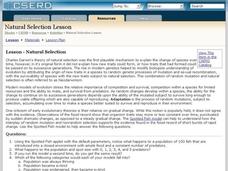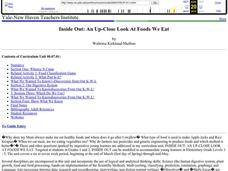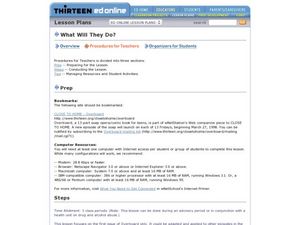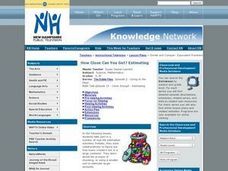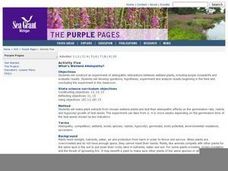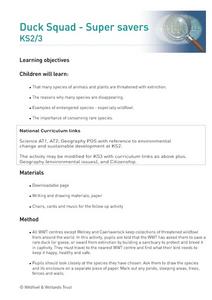Curated OER
Topographic Maps
In this topographic map worksheet, students learn how to read a topographic map and create a topographic map of their own using clay or Play-Doh. Students include contour lines by layering the clay. Students answer 6 questions about...
Curated OER
Designing A Study
In this designing a study worksheet, students conduct a study on all types of fish that live in the Hudson River. They complete 8 various types of questions that include mostly short answer in response to their findings. Students also...
Curated OER
Meteors and Meteorites
Students create Earth boxes containing some of Earth's biomes--desert, forest, tundra, ocean, and mountains. They simulate Earth's encounter with a comet trail and the resulting meteor shower. They present their Earth boxes to...
Curated OER
Hyperlink Habitats
Students explore an online Hyperlink Habitat to illustrate the interconnectedness of a tropical rainforest ecosystem. They create a map of the Hyperlink Habitat and research a local ecosystem and create their own print or Web version of...
Curated OER
Crossword: Rain Forest
In this crossword worksheet, students solve a crossword puzzle by solving clues about the Rain Forest. For example, "The area or environment where an animal lives."
Curated OER
Do You See What I See?
Second graders view a teacher-created terrarium, and complete a KWL chart. They discuss what they can see, Students go on a nature walk and compare the schoolyard to the terrarium, discussing the roles of rocks, plants, soil, and water...
Curated OER
Living, Non-Living Mobile
Students are introduced to the concept of living and nonliving organisms in general and participate in a starter activity where they build their own definitions of living and nonliving organisms.They sort organisms into living and...
Curated OER
Biology: Natural Selection
Young scholars explore evolutionary processes and theories using the spotted fish applet. They observe what happens to fish in a closed environment with both food and predators. Students run the model several times and answer questions...
Curated OER
Inside Out: An Up-Close Look At Foods We Eat
Fourth graders identify the origins of meats and vegetables consumed by humans on a daily basis. They classify foods (meats, dairy products, grains...) and create a food pyramid.
Curated OER
CLOSE TO HOME - Overboard
Young scholars read a comic about a teen drug overdose that leads to death. In this drug awareness lesson plan, students role play characters in the story that react to the death of their friend due to drug use in an online forum. Young...
Curated OER
How Close Can You Get? Estimating
Students work collaboratively to determine how many crackers are in a large container. They then view a video to see how often people use estimation in their jobs, and another video to watch students work on figuring out appropriate...
Curated OER
Be the Kiwi: New Zealand Introductory Activity
Young scholars get a taste of New Zealand. In this global studies instructional activity, students view photographs from the country and discuss its geographic location and features. Young scholars then participate in a scavenger hunt...
Google
Animation: Studio Logo
Logos just make a club seem more fun. Scholars incorporate knowledge from previous lessons in the unit to write a computer program in the Scratch block-based language. Their program should help design a logo for the CS First studio. A...
Teach Engineering
Storing Android Accelerometer Data: App Design
There's an app for that! Pupils learn to build an app that will store data on an Android. The instructional activity introduces class members to the tiny database, TinyDB, for Android devices. A video tutorial provides an...
Curated OER
Name that animal
A great way to classify organisms, is by counting the number of legs it has or how it moves. Little ones count the legs on five different creatures, then match the leg count to the proper animal name. Tip: Have them come up with other...
Curated OER
Analyzing the Relationship between Snowpack and River Flow
Students use the Internet to research current and past snowpack levels and river gauging station readings. They determine the relationship between snowpack and river flow. They predict future river flow.
Curated OER
Plastic Bag Pond
Students investigate the pond water from a local water source. They collect the pond water from the bottom or near vegetation in order to obtain the best sample possible. Then they use microscopes in class in order to examine the life...
Curated OER
Inventions 2: The Impact
Students explore innovators and inventions. In this technology lesson, students investigate the issues inventors face as they tackle new technology. Students design their own realistic needs-based invention.
Curated OER
What's Wetland Allelopathy?
Students study plants and what they need to thrive and survive. They make plant extracts from chosen wetland plants and test their allelopathic effects on the germination rate, radicle growth, and hypocotyl growth of test seeds of other...
Curated OER
Highs And Lows
Learners experiment to examine high and low pressure areas. They investigate why a high pressure area seeks a low pressure area.
Curated OER
Duck Squad-Super Savers
Students "save" a rare duck (or goose, or swan) from extinction by "building" a sanctuary to protect and breed it in captivity. They research what the bird needs and draw the species and its enclosure.
Curated OER
Ecosystems Lesson Plan
Students research ecosystems (rainforest, desert, grassland, woodland, and arctic tundra). Students compare the seven continents and the importance of proximaty to the equator.
Curated OER
Battery fun
Conduct an experiment with batteries to make a simple circuit. Fifth graders read the provided information, consider the two circuits, and determine which one is complete. An electrically charged experiment suggestion is included. Tip:...
Curated OER
Evaluate Ecosystems
Ninth graders conduct an environmental inventory on one ecosystem. They collect data, and write an environmental impact statement on that area. Students explain the interactions between different systems found within an ecosystem....







